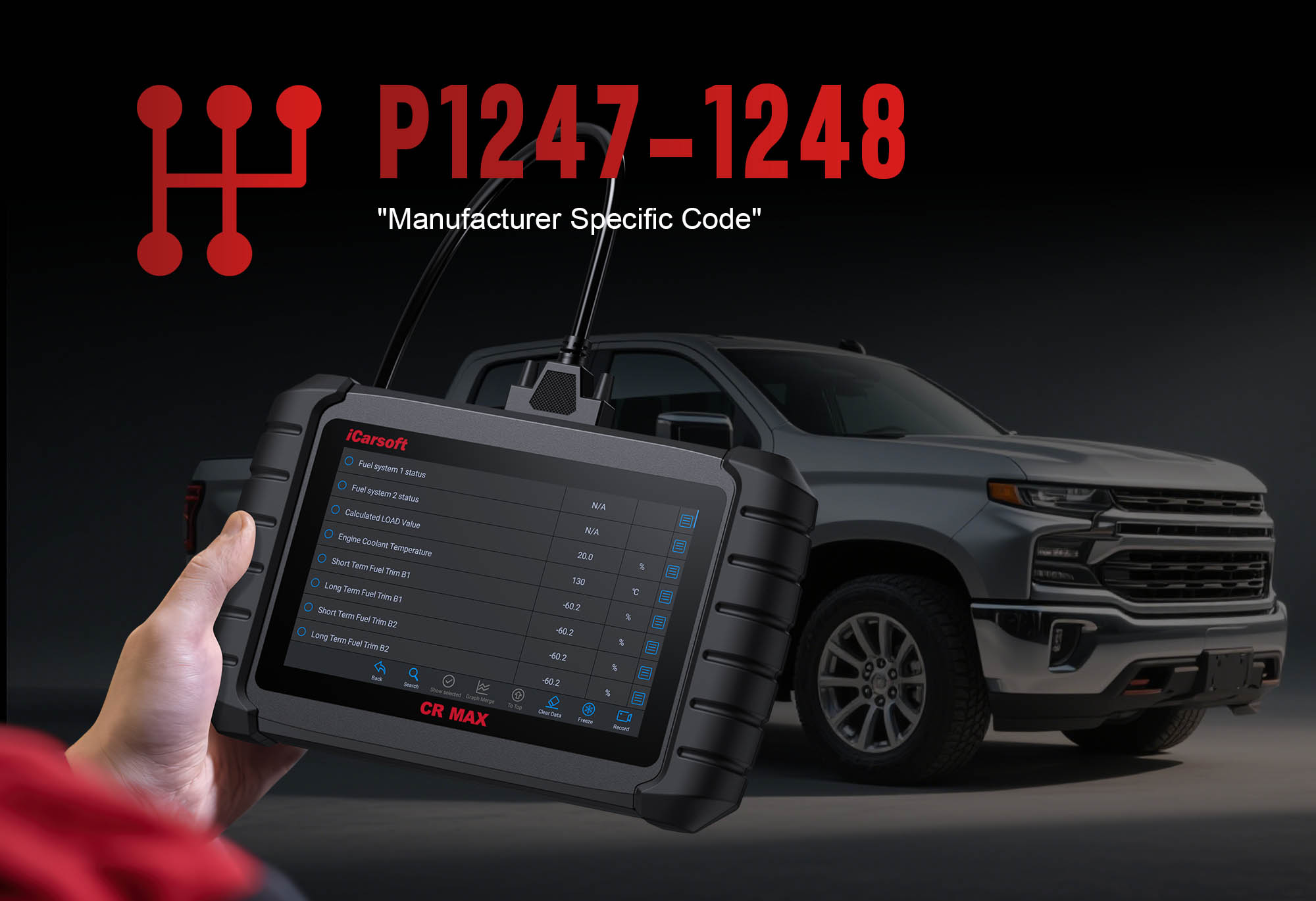Diagnose & Clear P1247-P1248 with iCarsoft CR MAX: Fix Turbo Boost Control Issues
If your check engine light glows and a scan returns P1247 or P1248, your turbocharged vehicle is flagging critical issues with its boost control system. These manufacturer-specific codes—most common in Ford, Lincoln, and Mercury models—point to electrical problems in the turbocharger boost control solenoid circuit.
P1247 indicates "Turbocharger Boost Control Solenoid A Circuit Low" (abnormally low voltage), while P1248 means "Turbocharger Boost Control Solenoid A Circuit High" (excess voltage). Both disrupt the solenoid’s ability to regulate the turbo’s wastegate, leading to underboost (reduced power) or overboost (potential engine damage).
The boost control solenoid acts as the turbo’s "traffic cop," using electrical signals from the Engine Control Module (ECM) to adjust vacuum pressure to the wastegate actuator. This controls how much exhaust gas spins the turbo, balancing power and safety. When the solenoid circuit fails, the turbo can’t maintain proper boost, triggering these codes.
Basic scanners might only label them "solenoid errors" but can’t distinguish between a faulty part, damaged wiring, or ECM issues. The iCarsoft CR MAX solves this with Ford-specific diagnostics, real-time solenoid monitoring, and circuit testing tools. Let’s walk through how to use it to fix P1247-P1248.
Why It Matters
Ignoring P1247 or P1248 risks more than just reduced performance—it threatens long-term damage to your turbocharger and engine. P1247 (low voltage) often causes underboost, leaving your vehicle sluggish and increasing fuel consumption by 10–15% as the ECM compensates for lost power. P1248 (high voltage) is even more critical: it can trigger overboost, where excess compressed air floods the engine, causing detonation (knocking), melted pistons, or blown head gaskets. To protect itself, the ECM may activate "limp mode," limiting power to ~50%—a temporary fix that masks the root issue. Over time, unregulated boost also wears out turbo bearings and seals, leading to a $1,500–$3,000 turbo replacement. Addressing these codes early with the CR MAX saves you from costly repairs and restores your vehicle’s intended performance.
Understanding P1247-P1248: Causes & Symptoms
To diagnose these codes effectively, start by recognizing their warning signs and underlying triggers:
Key Symptoms
-
Reduced Power (Underboost): Common with P1247—acceleration feels sluggish, especially when merging onto highways or passing.
-
Overboost Risk & Limp Mode: P1248 can push boost pressure above safe limits, forcing the ECM to activate limp mode to protect the engine.
-
Illuminated Check Engine Light: Triggers when solenoid voltage strays outside the normal 9–14V range (low for P1247, high for P1248).
-
Engine Hesitation: The engine may stumble or jerk during acceleration as boost pressure fluctuates unpredictably.
-
Increased Fuel Consumption: Both codes disrupt fuel-air balance, leading to inefficient combustion and higher gas mileage.
Common Causes
|
Cause
|
Description
|
|
Faulty Boost Control Solenoid
|
Internal coil damage or mechanical sticking disrupts voltage flow—common in high-mileage Ford EcoBoost models (100,000+ miles).
|
|
Wiring Issues
|
Frayed wires, corrosion, or loose connectors in the solenoid circuit (often near the intake manifold, where heat accelerates wear).
|
|
Vacuum Leaks
|
Cracked or disconnected hoses between the solenoid and wastegate actuator cause pressure loss, straining the solenoid circuit.
|
|
ECM Problems
|
Rarely, the ECM fails to send proper control signals—usually fixed with Ford’s latest software updates (via the CR MAX).
|
|
Blown Fuses
|
A tripped "Turbo Control" or "ECM B+" fuse cuts power to the solenoid—check the underhood fuse box (use CR MAX’s fuse map to locate).
|
Why iCarsoft CR MAX Is Perfect for These Codes
Basic OBD-II scanners can’t match the CR MAX’s ability to diagnose Ford-specific turbo solenoid issues—here’s why it stands out:
Ford-Specific Diagnostics
Preloaded with boost solenoid wiring diagrams, fuse locations, and test parameters for Ford models like F-150 EcoBoost, Focus ST, and Lincoln MKZ—no generic data.
Real-Time Solenoid Monitoring
Displays live voltage (9–14V target), duty cycle (0–100%), and ECM control signals—spot abnormalities (e.g., P1248’s >14V spikes) instantly.
Automated Circuit Testing
Runs checks for 12V power, ground integrity, and solenoid resistance (10–30Ω normal)—rules out wiring issues in minutes without a multimeter.
Solenoid Activation Tests
Manually triggers the solenoid to check for clicking (confirms movement) and boost pressure changes—verifies if the solenoid actually works.
Boost Pressure Correlation
Compares solenoid operation to actual boost pressure—ensures the system responds correctly (e.g., higher duty cycle = higher boost).
Auto VIN Detection
Automatically identifies your vehicle’s specs (e.g., 2023 Ford F-150 3.5L EcoBoost), ensuring you use the right test parameters for accurate results.
Step-by-Step: Diagnose P1247-P1248 with iCarsoft CR MAX
-
1. Connect & Confirm the Codes
Plug the CR MAX into your vehicle’s OBD-II port (under the dashboard) and power it on. Select your vehicle via Auto VIN (fast and accurate for Ford models) or manual entry (year/make/model). Navigate to Engine > Fault Codes > Read Codes to confirm P1247, P1248, or both. Tap Code Details for Ford-specific insights (e.g., "F-150 EcoBoost: Boost Solenoid Voltage <9V for 3 Seconds" or "Focus ST: Voltage Spikes >14.5V").
-
2. Check for Related Issues
These codes often pair with other turbo problems that worsen solenoid strain. Use the CR MAX to scan for:
- P0234 (overboost) or P0299 (underboost)
- P0171/P0174 (lean fuel mixture, caused by boost leaks)
Address these first—resolving them may eliminate P1247-P1248 without further repairs.
-
3. Monitor Live Solenoid Data
Go to Engine > Live Data > Turbo/Supercharger and select three key parameters:
- "Boost Control Solenoid Voltage" (target: 9–14V)
- "Solenoid Duty Cycle" (0–100%—should rise with throttle input)
- "Actual Boost Pressure" (compare to "Desired Boost Pressure").
Start the engine and accelerate gently:
- P1247 Cause: Voltage drops below 9V (check power supply/fuse).
- P1248 Cause: Voltage spikes above 14V (check for wiring shorts).
-
4. Locate & Inspect the Solenoid
Use the CR MAX’s Component Location tool to find the solenoid (usually mounted on the intake manifold or firewall). Visually inspect:
- Electrical Connector: Look for green corrosion or bent pins—clean with electrical contact cleaner if needed.
- Vacuum Hoses: Check for cracks, dry rot, or disconnections (replace damaged hoses with OEM-spec lines).
- Solenoid Body: Oil contamination indicates a failing turbo seal—address this before replacing the solenoid.
-
5. Test the Solenoid Circuit
Wiring issues often mimic a faulty solenoid—use the CR MAX to verify. Navigate to Special Functions > Engine > Solenoid Tests > Boost Control Circuit Test. Follow the tool’s prompts to run three critical checks:
- Power Supply Check: Ensures 12V reaches the solenoid (failed = blown fuse or broken wire).
- Ground Test: Verifies proper ground (resistance <0.5Ω—high resistance = corroded ground strap).
- Resistance Test: Measures solenoid coil resistance (10–30Ω is normal—out of range = faulty solenoid).
-
6. Activate the Solenoid Manually
Go to Special Functions > Engine > Solenoid Tests > Boost Control Activation. The CR MAX will cycle the solenoid through 0–100% duty cycle while you:
1. Listen for a clicking sound (confirms the solenoid’s internal valve moves).
2. Watch "Actual Boost Pressure" on the CR MAX—pressure should rise/fall with duty cycle changes.
No clicking or pressure change = faulty solenoid (needs replacement).
-
7. Check for Vacuum Leaks
Leaky hoses cause erratic boost, straining the solenoid. With the engine off:
1. Disconnect the vacuum hose from the solenoid.
2. Blow into the hose—air should flow freely (blockage = clogged line; replace immediately).
3. With the engine running, spray soapy water on all boost/vacuum hoses—bubbles indicate leaks (seal with high-temp silicone or replace hoses).
-
8. Repair & Clear the Codes
Fix the root cause based on diagnostics:
- Faulty Solenoid: Replace with an OEM part (use the CR MAX’s Part Lookup—e.g., Ford BL3Z-9K378-A for F-150 EcoBoost).
- Wiring Issues: Splice frayed sections with heat-shrink connectors; replace corroded connectors.
- Blown Fuse: Replace with a fuse of the correct amperage (check CR MAX’s fuse map for specs).
- ECM Update: Use Special Functions > ECM > Software Update to install Ford’s latest turbo control firmware.
Reset adaptive values: Go to Special Functions > ECM > Reset Adaptive Values to clear learned parameters.
Clear codes: Navigate to Engine > Fault Codes > Clear Codes to delete P1247-P1248.
-
9. Verify the Repair
Take a 30-minute test drive that includes highway speeds (60–70 mph) and moderate acceleration. Use the CR MAX’s Data Logging to record solenoid voltage, duty cycle, and boost pressure. After driving, re-scan for codes: No P1247-P1248 + matching actual/desired boost pressure = successful repair!
Preventing P1247-P1248 Recurrence
Use the iCarsoft CR MAX to maintain a healthy turbo boost control system and avoid future codes:
-
Quarterly Solenoid Checks: Run Special Functions > Engine > Solenoid Tests > Boost Control Health Scan to test resistance and voltage stability.
-
Vacuum Hose Inspections: Check hoses during oil changes—replace every 3–5 years (or sooner if cracked/dry) to prevent leaks.
-
Connector Protection: Apply dielectric grease to the solenoid’s electrical connector to prevent corrosion from moisture or heat.
-
ECM Software Updates: Use the CR MAX’s One-Key Upgrade to install Ford’s latest turbo control software—fixes bugs that cause voltage irregularities.
-
Annual Fuse Checks: Test the turbo control and ECM fuses using the CR MAX’s fuse map—replace weak fuses before they blow.
Summary Table
|
Step
|
Action
|
|
1
|
Connect CR MAX, confirm P1247-P1248, and review Ford-specific details
|
|
2
|
Scan for related codes (P0234, P0299, P0171/P0174) and address them
|
|
3
|
Monitor live solenoid voltage, duty cycle, and boost pressure
|
|
4
|
Locate and visually inspect the solenoid, connectors, and hoses
|
|
5
|
Test the solenoid circuit (power, ground, resistance)
|
|
6
|
Manually activate the solenoid to check movement and boost response
|
|
7
|
Check for vacuum leaks with soapy water and air pressure
|
|
8
|
Repair issues, reset ECM adaptive values, and clear codes
|
|
9
|
Test drive, log data, and re-scan to verify the fix
|
Final Thoughts
P1247 and P1248 might seem like intimidating electrical issues, but the iCarsoft CR MAX simplifies diagnosis with Ford-specific tools and real-time monitoring. It eliminates the guesswork that leads to unnecessary solenoid replacements—instead, it helps you target the root cause, whether it’s a corroded wire, blown fuse, or vacuum leak.
For Ford, Lincoln, and Mercury owners, this tool is a game-changer: it turns complex turbo control problems into straightforward repairs, saving time and avoiding costly dealer visits. By addressing P1247-P1248 promptly, you protect your turbocharger, restore full power, and ensure your vehicle runs efficiently for years to come.
FAQs About P1247-P1248 Codes
Q: Can I drive my Ford with P1247 or P1248?
A: Short-term driving (e.g., to a repair shop) is possible if you avoid hard acceleration, but long-term use is risky. P1248’s overboost can damage the engine, while P1247’s underboost strains other components. Use the CR MAX to diagnose the issue within 1–2 days of seeing the code.
Q: How much does it cost to fix P1247-P1248?
A: Costs vary by cause: Replacing a fuse = $5–$10; fixing wiring/hoses = $20–$100; replacing a solenoid = $80–$250 (OEM for Ford); ECM updates = $0 (DIY with CR MAX). The CR MAX helps avoid expensive turbo repairs by catching issues early.
Q: Why do P1247-P1248 keep coming back after I clear them?
A: You likely missed the root cause. Common oversights: Unrepaired vacuum leaks (small cracks are hard to spot), corroded ground straps (not just the solenoid connector), or outdated ECM software. Use the CR MAX’s data logging to capture when codes return—this reveals patterns (e.g., only at high RPMs) that point to the issue.
Q: Do I need to replace the turbo if I have P1247-P1248?
A: Rarely. These codes almost always stem from the solenoid, wiring, or hoses—not the turbo itself. The CR MAX’s solenoid activation test and boost pressure correlation will confirm if the turbo is working: if boost pressure responds to solenoid duty cycle changes, the turbo is fine. Only replace the turbo if tests show mechanical failure (e.g., no boost despite proper solenoid operation).





